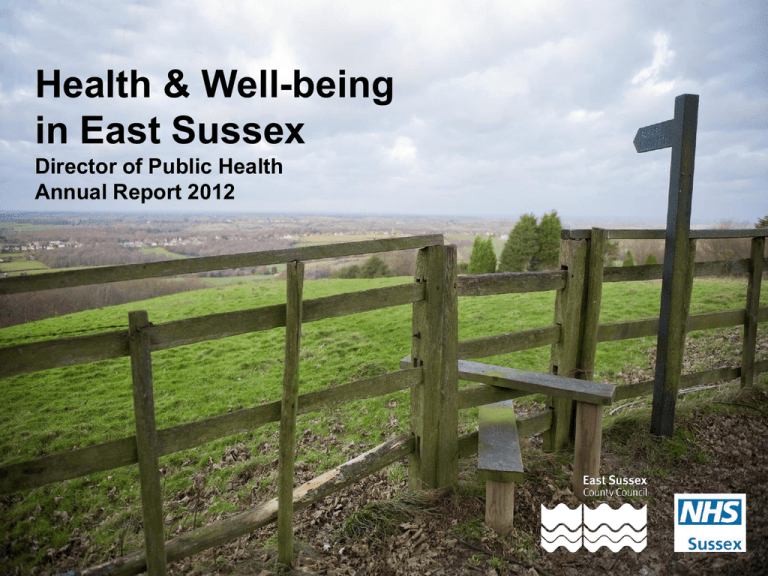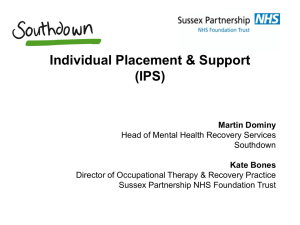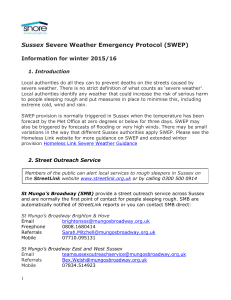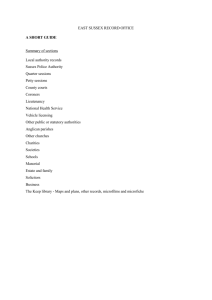Health and Well being in East Sussex powerpoint presentation
advertisement

Health & Well-being in East Sussex Director of Public Health Annual Report 2012 2012 Report • Health Priorities for East Sussex • Health and Lifestyle • Effective Public Health Interventions and Services Chapter 1: Health Priorities for East Sussex • life expectancy and the wider determinants of health – 15 year life expectancy gap between wards; • chronic disease, cancer and mental health; • improving and protecting health by encouraging healthy lifestyle; • older people; • accidents and falls; • end of life. Chapter 1: Health Priorities for East Sussex It is recommended that the Health and Wellbeing Board should ensure that action is taken through the commissioning plans for health and social care services to tackle the six priority areas identified by the JSNA health profiles to improve health and reduce health inequalities in East Sussex. District/Borough Priorities Chapter 2: 2011 Health & Lifestyle Survey – key findings • The percentage of people reporting ‘good’ to ‘excellent’ health in 2011 (78%) is statistically significantly lower than in 1992 (84%). • 33% of East Sussex residents reported having a long-standing illness, disability or health problem, in 2011 compared to 28% in 1992, which is statistically significantly higher. • Health status scores have changed little over 20 years. • The percentage of people at risk of major depression has not changed over the last 20 years. It remains at 32%. • In 1992, 26% of people in East Sussex were smokers and in 2011 this has statistically significantly decreased to 18%. Hastings (25%) and Eastbourne (20%) have the highest percentage of smokers. Change in percentage of smokers 1992-2011 30 20 15 10 change from 1992 5 Filled drops indicate a statistically significant change 2011 District/Borough HL HW CCHC HRCC Wealden Rother Lewes Hastings Eastbourne 0 East Sussex Percentage 25 Clinical Commissioning Group Chapter 2: 2011 Health & Lifestyle Survey – key findings • The percentage of people drinking alcohol has not increased between 1992 and 2011, but those ‘increasing risk’ or ‘higher risk’ drinkers have increased. So, drinkers are drinking more. • Physical activity has increased. • Fruit and vegetable consumption has increased and the percentage of 5 or more portions of fruit and vegetables per day. • 52% of people still think they are overweight. Change in the percentage of drinkers who are increasing risk and higher risk drinkers between 1992 and 2011 20% 18% 16% 12% 10% 8% 6% 4% change from 1992 2% 2011 Filled drops indicate a statistically significant change District/Borough HL HW CCHC HRCC Wealden Rother Lewes Hastings Eastbourne 0% East Sussex Percentage 14% Clinical Commissioning Group Change in the percentage of people participating in 30 minutes of exercise on at least 5 days per week between 1992 and 2011 30% 20% 15% 10% Filled drops indicate a statistically significant change change from 2003 5% 2011 District/Borough HL HW CCHC HRCC Wealden Rother Lewes Hastings Eastbourne 0% East Sussex Percentage 25% Clinical Commissioning Group Change in the percentage of people eating at least 5 portions of fruit and vegetables per day between 1992 and 2011 60% 40% 30% 20% change from 2003 10% Filled drops indicate a statistically significant change 2011 District/Borough HL HW CCHC HRCC Wealden Rother Lewes Hastings Eastbourne 0% East Sussex Percentage 50% Clinical Commissioning Group Healthy Foundations Population Segmentation • Healthy Foundations is a lifestyle segmentation model which sets out to ensure that all public health interventions are informed by an understanding of what motivates people. • Makes it possible to tailor interventions or services to particular segments to achieve behaviour change. Healthy Foundations Population Segmentation Healthy Foundations Population Segmentation Healthy Foundations Population Segmentation Healthy Foundations Population Segmentation Healthy Foundations Population Segmentation Healthy Foundations Population Segmentation Healthy Foundations Population Segmentation 100% 90% 17% 14% 14% 12% 21% 25% 23% 22% 80% 70% 14% 14% 26% 24% 15% 28% 60% 50% Health Conscious Realists 18% 24% 25% 26% 24% 23% 22% 40% 25% 24% 21% 24% 19% 15% 14% 15% 15% 16% 15% Eastbourne Hastings Lewes Rother Wealden 20% 10% Unconfident Fatalists Live for Todays Hedonistic Immortals 23% East Sussex 25% England 30% Balanced Compensators 20% 0% Chapter 2: 2011 Health & Lifestyle Survey – Recommendations 1. The results from the health and lifestyle surveys should be used to: – provide a baseline for monitoring the impact of interventions and services designed to improve health and well-being; – provide information that could be used to plan new services; – highlight areas to explore further, especially in terms of health inequalities; – inform targeting of health and social care resources appropriately in order to improve the health of the population. 2. The Healthy Foundations Lifestyle Segmentation Model analysis should be used to tailor interventions and services to specific population segments, in order to improve their effectiveness and efficiency in changing behaviours. Chapter 3: Effective public health actions • Evidence review of primary public health actions. • A summary of what is currently in place in East Sussex • Recommendations for actions for commissioners in each public health area: Smoking Diet and weight Alcohol and drugs Accident Prevention Physical Activity Mental Wellbeing










